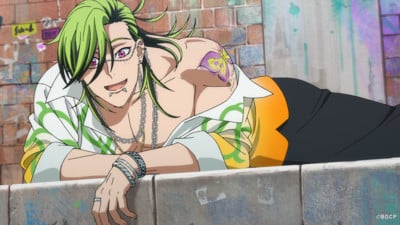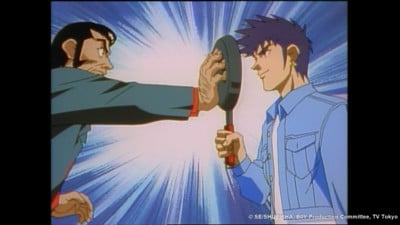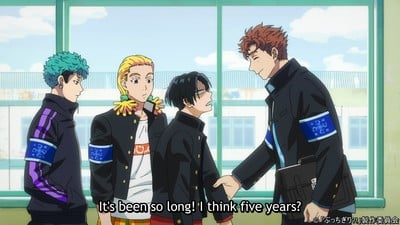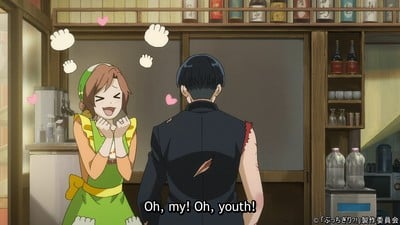Bucchigiri?! is reintroducing the anime world to delinquent culture, but is this homage to old-school bad boys refreshing or lost on modern audiences?
Bucchigiri?!, Tokyo Revengers (first season), Kenka Banchō Otome: Girl Beats Boys, Yū Yū Hakusho, Hajime no Ippo, JoJo’s Bizarre Adventure, and Cromartie High School are streaming on Crunchyroll. Tokyo Revengers (subsequent seasons) is streaming on Hulu. Hareluya II Boy is streaming on HIDIVE, and Kamen Rider Fourze (first two episodes) is streaming on YouTube.
Disclaimer: The views and opinions expressed by the participants in this chatlog are not the views of Anime News Network.
Spoiler Warning for discussion of the series ahead.
Chris
Nick, did you hear? Some punks from the rival anime news website downtown were talking shit about the TWIA crew! We gotta get the gang together to go down there and teach ’em a lesson!
Nick
Heh, so those posers think they can take us on? Alright boys, grease up your pompadours, practice your most disrespectful squats, and get ready to show these losers who run the anime discourse in this city!

Yes, if all the rolled r’s and misaimed machismo hadn’t clued you in, delinquency is back on the discussion docket for this season thanks to
Bucchigiri?!. This bizarre little breakout series blends the Middle Eastern folklore of
One Thousand and One Nights, of all things, with the time-honored tradition of tough-talkin’, hard-hittin’ Japanese schoolboys.

It’s all filtered through the specific vision of
Hiroko Utsumi, whose touch, uh, is obvious.
I dunno what you could mean. This seems par for the course with the subgenre.

Look, after she figured out how to have someone pull off a skateboarding kabedon in
Sk8 the Infinity, I’m not surprised her next project saw her throwing all complicating concepts out and directly feature dudes smashing their bodies together.

Yeah, but that’s just a natural part of the whole setup. Guys roughhousing. Dudes form friendships and rivalry through physical contact. Bros experiencing emotions their societal role models for masculinity haven’t prepared them for, and displacing those feelings into violence as their only means of emotional connection or catharsis. Nothing straighter than that!

That makes it only a little funny that Arajin, the show’s main boy, is the most singularly hetero-minded guy among the rest of the show’s cast, being all about that brawling bromance. This desperate wimp has virtually no interest in the heated drama between men nor in communicating with his fists. He looks like he wandered off another set into this exhibit of characters appealing to the
Free! and
Sk8 crowds. He is the opposite of the main character you’d want or expect from a delinquent series, which is only one contributing quirk of the many in this particular genre revival.

He would be the weedy friend of the actual main character in any delinquent anime. Even in shows that aren’t exclusively about dudes beating the brakes off one another, you don’t make the scrawny guy obsessed with the first girl to talk to him your protagonist. That’s more like an isekai thing these days.
Perhaps that’s how to ease the audience into the vibes of all this brawling beefcake. Delinquents in anime are more likely to be one-off jobbers or punchlines these days than starring in shows themselves (reflecting a decline in this kind of delinquent culture in Japan itself). What is a classically graffitied-up school run by punks and their punch-based politics if not another world for an out-of-his-depth lead to be transported to?

True, the whole delinquent aesthetic is pretty antiquated these days. Even Tokyo Revengers, the other modern revival of the genre, had to set itself in the early 2000s and makes it a plot point that roving gangs of high school students were out of vogue even then. Arajin going here in 2024 is like a kid today walking into a school full of homoerotic greasers.
Tokyo Revengers being the prominent modern standard-bearer for this subgenre, and the time-traveling way it goes about that does make a point about the power of pop-cultural osmosis. Even without regular stories dedicated to them, there’s that persistent audience awareness of the lifestyle synonymous with those big jackets and bad hairdos.

In much the same way gyaru characters in anime don’t correlate with real-life gyaru fashion or culture anymore, Delinquent/Yankee/Banchou characters in anime are largely built on impressions of an impression. There have always been teenagers who break the law, but the visual language that mass media uses to portray them is somewhat stuck in the ’80s. So
Bucchigiri?! adding the Middle Eastern flair AND making all these neon-haired boys thirsty is honestly pretty refreshing.

Part of me wonders how much of that was a conscious reinvention and how much is just Utsumi’s established appreciation for Arabian aesthetics. Either way, I ain’t complaining.

Oh, for sure. The bright colors and flamboyant uh, musculature work well with the classic gang war and martial arts. I also appreciate that they still keep the boys looking buff (Arajin notwithstanding). Previous attempts at leaning into the female fandom for bad boys like
Kenka Banchou Otome had all these supposedly violent ass-kickers featuring the same build and personalities as your typical idol anime.

Kenka Banchou Otome is funny because it’s a spin-off of a broader
franchise that features much more typically typecast dudes duking it out.

Otome’s premise also features a cross-dressing girl beating up her potential paramours as part of her courtship of them, which is honestly a galaxy-brain setup that was ahead of its time, in my opinion.

They were so ahead that they forgot to give it any budget and left it to die as a half-length show nobody but us remembers. For as much deserved bad press as MAPPA has gotten, I’m glad they at least dared to put all their cream into this crop.
We’re definitely in a different time from a short-anime adaptation of a video-game spin-off getting simulcasted (and dubbed!), presumably because it was a cheap license. I never want to speculate or jinx too hard what might be going on behind the scenes on a
MAPPA production, but all their hard work has paid off thus far in making
Bucchigiri?! look prestigious.

It’s wild because it maintains a lot of the trashy, gritty design aspects you’d expect from series like this, but with all the pop and riotous colors carrying over from
Sk8 the Infinity.
There are some rough patches, but overall, it’s an inspired realization of a style that has mostly existed as a throwback for quick gags. It helps that the action is well realized, featuring some fantastic martial arts choreography that is a goddamn breath of fresh air after three seasons of
Tokyo Revengers looking like this:

And that’s one of the better-looking fights in that show.
Having a show about brawling boys without the fights looking good is hard.
Bucchigiri?! also works to embody the classical heart of those fights. It’s working off of the idealized memories of the banchō heyday, compared to the more brutal approach exemplified in
Tokyo Revengers.

Not that the fights in
Bucchigiri?! can’t be dangerous, but they’re deliberately harkening back to that belief that young men could best understand each other by honorably communicating with their fists.
That’s the romance surrounding this whole subgenre, especially the nostalgia I hold for it. While not realistic, there’s a simplistic appeal to the kind of gold-hearted machismo that delinquent protagonists represent. The idea of a rough-looking guy who can turn other dudes into sidewalk decorations but ultimately does it for the “right” reasons holds a lot of appeal. That’s more or less the foundation classics like
Yū Yū Hakusho were built on, even before you got to any supernatural fights or demons.

You’d see this appreciation even in the late ’80s when the delinquent style was already on its way out. Authors would deliver series like
Hajime no Ippo or
Great Teacher Onizuka, which featured grown-up badasses in those sorts of mentor roles.


This move from high school mob to adult mentor was aided by the fact that most of these characters already look like they’re in their 40s. I guess smoking behind the school turns people older.
As proper delinquency as a culture started to fall off, maybe that helped these anime kids start being drawn more like kids again. You can even see that happen in real-time, with
JoJo’s Bizarre Adventure deploying the aesthetic in two different ways across two different installments twice in a row. There’s a reason Jotaro doesn’t look out of place, tromping around the globe with a bunch of men past their thirties.


Sidebar, but as much as global cultural osmosis of Japanese delinquents has increased in recent years, I’m going to need it to step up even more so that every single classically banchō-styled character doesn’t get a chorus of people assuming they’re specifically a Jotaro homage.
Look, sometimes cultural imports get skewed like that. In a world where most people think Hareluya II Boy is the sound of somebody choking during choir practice, you’re going to have a lot of people getting Banchou Baby Vibes whenever they see a guy with a pompadour or a goofy little hat.
As alluded, the style is an effective visual character shorthand, even if its consistent deployment also means it gets subverted as often as not. So you get stuff like
Kamen Rider Fourze‘s Gentaro rocking up in this getup unironically in 2011 and not hiding his heart of gold behind any gruff exterior.


It’s a small wonder they got this guy to play the live-action version of
Bleach‘s Ichigo, another character who slots into that delinquently styled shonen hero setup, if a bit more modern.
Honestly, subversions are probably the norm these days. There are tons of shows with punk characters whose entire joke is that they’re secretly super sweet and wholesome. There’s the Holstein club in Silver Spoon, Kanji in Persona 4, and tons of others. Were it not for the lingering visual shorthand of “gruff dude who roles his R’s,” younger viewers could be forgiven for not understanding the joke at all since its set up is decades in the past.
Hell, Angel Densetsu was on this train back in the ’90s, where the entire gag was that the scary-looking main character was the sweetest boy alive, but nobody at his school believed it for ten years of publication.
That will be the case when your foundational culture was already cleaning up its act as early as the ’70s. It’s arguably the broad case, but especially for anime fans in our corner of the world from our generation, the delinquent style has primarily been a joke most of the time we’ve seen it. They were able to make
Cromartie High School work over here despite being several cultural degrees off from any target audience.

Granted, this is because
Cromartie is a riot in its own right and only becomes funnier the more you learn about the lifestyle it’s lampooning.
Honestly,
Cromartie is only one or two degrees of absurdity removed from totally serious entries. A guy eating pencils to look tough is only a short throw from Hareluya Hibino using his powers as the literal son of Jehovah to magically summon a frying pan to beat on high school seniors who look like 40-year-olds.

Yeah, I can remember the “hardcore,” “serious” early chapters of
Yu Gi Oh! featuring a band of delinquent schoolkids committing yo-yo-based violence—these stories know how to roll with this stuff. In many ways, that’s part of the purpose. Teen boys are kinda dumb, and demonstrating their machismo in goofy, potentially stupid ways is part of the way they grow up.

Embracing that goofiness lets it be painted in a positive, romanticized light.
The genre’s heyday was decades before the phrase entered parlance, but at its best, delinquent anime does embody the essence of Dudes Rocking.

In that respect,
Bucchigiri?!‘s greatest innovation is embracing the idea that some people might just be into these dumb, feral, puppy dog boys.
The series certainly has no shortage of variety in its collection of attractive ass-kickers. This includes the 21-year-old held-back student who carries on the proud tradition of looking like he’s in his 40s and the jovial jacked genie who might want our main character’s body for multiple less-than-scrupulous reasons.


I’m sure it’s fine. Nothing untoward about the way Senya keeps staring at Arajin’s magic tramp stamp.

Sidenote: Arajin should start working out his glutes if he wants to get tougher. Boy has an ass that quits at 3:30 pm on Wednesdays right now.
We joke, but statistically, there’s got to be someone in the audience for whom Arajin’s option of a Filet-O-Fish is the most appealing among this sea of beef. Surely, he’s got something going on apart from being the audience’s entry into anachronistic delinquent culture.

Or maybe he is just here to suck in the more realistic ways teen boys do compare to all the more romanticized versions he’s surrounded by.
Honestly, Arajin’s the biggest millstone around the show’s neck. He’s improved in recent episodes, but practically every other character with a speaking role is more entertaining or interesting than him. Matakara is a human golden retriever who seems to have only gotten into gang warfare because it makes working out easier, but he at least can get into a fight without pooping himself.

I remember this being my issue with
Tokyo Revengers, too. Viewing the series through Takemichi’s perspective was just frustrating, witnessing the events of the actual active badasses while being too dense to figure out how to contribute half the time.

Is this an inherent issue for “modern” delinquent stories? We’re now so far removed from their culture that they necessitate these kinds of POV people to contextualize things for the audience better? We can’t just drop a dude with a pompadour in front of them and expect them to know what that means out of the gate.
Arajin isn’t nearly as frustrating as Takemichi, at least not yet. But the evolution for modern audiences isn’t entirely negative. It used to be that every girl in a show like this existed as, at most, a nagging love interest for the male lead to snark at. Now they get to be just as toxic as the guys!

The only straight romance option in this series being a psychotic bro-con is another of
Bucchigiri?!‘s brilliant evolutions. It goes a long way towards making the driving plotline of Arajin’s courtship of her that much more tolerable.

Arajin’s also got a cool mom, but I feel cool moms have been more common throughout the delinquent series.

I’m not sure if you’d call Yusuke’s mom “cool,’ but she was a favorite among a certain audience segment.
Part of me feels like Arajin’s mom might be more of Utsumi’s viewpoint character, a la Gou from
Free!. Even saddled with Arajin as the vector, this is all followed through, and with this genie business that I’m still not sure where it’s going, there’s a knowingness to
Bucchigiri?!‘s treatment of the material. Despite all its absurdities, it never feels like it’s directly riffing on the pop-cultural concept of delinquents the way something like
Cromartie does.

I know we’re living in an era of more sincere throwback revivals, but it’s also nice to see in this case.
That keeps it working, where the more sincere and serious Tokyo Revengers ultimately floundered. It’s playing in the genre space and paying homage to its history in many respects, but Bucchigiri?! brings its spices and proclivities to the table. For all our joking, the conscious choice to lean into the subtextual homoeroticism of it all does a lot to set it apart.
Bucchigiri?! is also an original series that (probably) isn’t going to run for 50 episodes and counting the way
Tokyo Revengers has. The delinquent anime of yesteryear were often based on an equally classic manga and got to air for ages. But that, too, was a different time. Being in an era where it can schedule its story to be tighter and, yes, be a little more open about these dudes’ bonding helps. That’s the best way to keep old genres going—you don’t just revive them, you evolve them.

But also somebody to license Angel Densetsu god dammit. Do it for me. Or else the boys and I are gonna loiter and smoke outside your business until some spiky-haired kid with too much to prove tries to stop us.
We mean it. We’ve learned the best of brawling from watching all this delinquent anime, and we aren’t afraid to prove it.












































![For the Fans[ervice] - This Week in Anime](https://theanimenews.net/wp-content/uploads/2024/11/1732205217_For-the-Fanservice-This-Week-in-Anime-390x220.webp)
